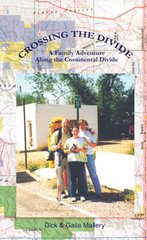
Bike Access to Continental Divide Trail Threatened
The International Mountain Bicycling Association is upset that The Forest Service is trying to scale back their access to the Continental Divide National Scenic Trail. I’m all for it. You will not convince anyone who shares trail on heavily used mountain bike routes that they have the same impact as hiking. That is a grand exaggeration of the facts. Mountain Bike tires powered by human muscle tear up trail in much the same way as Off Road motorized vehicles. The million hours spent on volunteer trail maintenance consist mostly of working on eroded areas that have taken a beating from an over use of mountain bikes. The following IMBA information must be taken with a large grain of salt:
The Forest Service suggests prohibiting mountain biking where use is currently allowed on the CDNST. The proposed policy also singles out bicycling as an undesirable use that should be subject to additional scrutiny and restrictions. These include a burden of proof that bicycling "would not substantially interfere with the nature and purposes of the CDNST," which the Forest Service deems to be hiking and horse travel.The International Mountain Bicycling Association (IMBA) believes that the Forest Service directive should not discriminate against bicycling on the CDNST.
The CDNST is a public trail and potential uses should be considered equally. It is unfair to discriminate against bicycling when scientific research has shown its impacts to be similar to hiking and less than equestrian use.With 40 million participants, mountain biking is the second most popular trail activity in the country (Outdoor Industry Foundation, 2007). This large constituency helps lobby for public lands funding and donates nearly one million volunteer hours each year to trail construction and maintenance. Mountain bikers can be valuable partner for the CDNST by helping build and maintain trail, and by lobbying for its completion.IMBA is not asking for access to the entire CDNST and respects the ban on bicycling in existing Wilderness areas. Some non-Wilderness sections may be suitable as hiking and/or horse-only, but along the 3,100 miles there is room enough for multiple uses in most areas.
Unfortunately, the newly proposed Forest Service directives specifically target only motorized and bicycle travel, even though bicycling is a quiet, low-impact, human-powered activity and science has shown the impacts of mountain bicycling to be similar to hiking and far less than horse or OHV use.The IMBA / Forest Service Memorandum of Understanding states mountain bicycling should be managed distinctly from motorized travel. It also says mountain bicycling is appropriate in areas listed as "primitive" on the Recreation Opportunity Spectrum. These areas comprise a significant percentage of the CDNST.
The International Mountain Bicycling Association is upset that The Forest Service is trying to scale back their access to the Continental Divide National Scenic Trail. I’m all for it. You will not convince anyone who shares trail on heavily used mountain bike routes that they have the same impact as hiking. That is a grand exaggeration of the facts. Mountain Bike tires powered by human muscle tear up trail in much the same way as Off Road motorized vehicles. The million hours spent on volunteer trail maintenance consist mostly of working on eroded areas that have taken a beating from an over use of mountain bikes. The following IMBA information must be taken with a large grain of salt:
The Forest Service suggests prohibiting mountain biking where use is currently allowed on the CDNST. The proposed policy also singles out bicycling as an undesirable use that should be subject to additional scrutiny and restrictions. These include a burden of proof that bicycling "would not substantially interfere with the nature and purposes of the CDNST," which the Forest Service deems to be hiking and horse travel.The International Mountain Bicycling Association (IMBA) believes that the Forest Service directive should not discriminate against bicycling on the CDNST.
The CDNST is a public trail and potential uses should be considered equally. It is unfair to discriminate against bicycling when scientific research has shown its impacts to be similar to hiking and less than equestrian use.With 40 million participants, mountain biking is the second most popular trail activity in the country (Outdoor Industry Foundation, 2007). This large constituency helps lobby for public lands funding and donates nearly one million volunteer hours each year to trail construction and maintenance. Mountain bikers can be valuable partner for the CDNST by helping build and maintain trail, and by lobbying for its completion.IMBA is not asking for access to the entire CDNST and respects the ban on bicycling in existing Wilderness areas. Some non-Wilderness sections may be suitable as hiking and/or horse-only, but along the 3,100 miles there is room enough for multiple uses in most areas.
Unfortunately, the newly proposed Forest Service directives specifically target only motorized and bicycle travel, even though bicycling is a quiet, low-impact, human-powered activity and science has shown the impacts of mountain bicycling to be similar to hiking and far less than horse or OHV use.The IMBA / Forest Service Memorandum of Understanding states mountain bicycling should be managed distinctly from motorized travel. It also says mountain bicycling is appropriate in areas listed as "primitive" on the Recreation Opportunity Spectrum. These areas comprise a significant percentage of the CDNST.












No comments:
Post a Comment